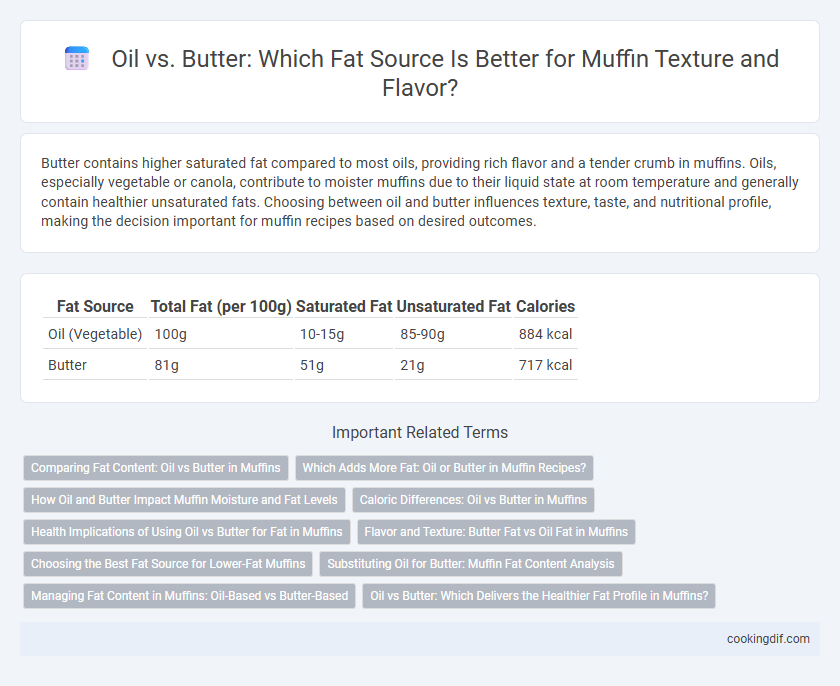Butter contains higher saturated fat compared to most oils, providing rich flavor and a tender crumb in muffins. Oils, especially vegetable or canola, contribute to moister muffins due to their liquid state at room temperature and generally contain healthier unsaturated fats. Choosing between oil and butter influences texture, taste, and nutritional profile, making the decision important for muffin recipes based on desired outcomes.
Table of Comparison
| Fat Source | Total Fat (per 100g) | Saturated Fat | Unsaturated Fat | Calories |
|---|---|---|---|---|
| Oil (Vegetable) | 100g | 10-15g | 85-90g | 884 kcal |
| Butter | 81g | 51g | 21g | 717 kcal |
Comparing Fat Content: Oil vs Butter in Muffins
Butter contains about 81 grams of fat per 100 grams, consisting of saturated and unsaturated fats, whereas vegetable oil generally has around 100 grams of fat per 100 grams, primarily unsaturated fats. In muffin recipes, using butter results in richer flavor and a denser crumb due to its saturated fat content, while oil creates a moister, lighter texture because of its liquid unsaturated fats. Choosing oil or butter directly impacts the fat profile and texture of muffins, where oil increases unsaturated fat intake and butter contributes more saturated fat.
Which Adds More Fat: Oil or Butter in Muffin Recipes?
Butter contains approximately 81 grams of fat per 100 grams, while oil averages around 100 grams of fat per 100 grams, making oil the ingredient that adds more fat to muffin recipes. The type of fat differs, with butter providing saturated fats and oil often contributing unsaturated fats, which can impact the muffin's texture and flavor. Choosing oil typically results in a moister muffin due to its higher fat content and liquid state at room temperature.
How Oil and Butter Impact Muffin Moisture and Fat Levels
Oil increases muffin moisture by coating flour proteins and limiting gluten formation, resulting in a tender, softer crumb with higher fat content. Butter, containing about 80-82% fat and water, contributes to a richer flavor but adds less moisture due to its water content, which can create a slightly denser muffin texture. Choosing oil boosts fat content and moisture retention, while butter provides flavor complexity with moderate fat and moisture levels.
Caloric Differences: Oil vs Butter in Muffins
Oil contains approximately 120 calories per tablespoon, while butter has about 102 calories per tablespoon, influencing the overall caloric density of muffins. Using oil in muffin recipes typically results in a slightly higher calorie count due to its pure fat content, whereas butter's composition includes water and milk solids, reducing its caloric concentration per volume. This difference affects muffin texture and moisture, with oil often producing a denser, moister crumb compared to butter.
Health Implications of Using Oil vs Butter for Fat in Muffins
Oil contains primarily unsaturated fats, which are associated with improved heart health and lower cholesterol levels, making it a healthier fat choice for muffins. Butter, rich in saturated fats and cholesterol, can contribute to increased LDL levels and potential cardiovascular risks when consumed in excess. Choosing oil over butter in muffin recipes can lead to a lighter texture while supporting better lipid profiles and overall cardiovascular health.
Flavor and Texture: Butter Fat vs Oil Fat in Muffins
Butter contains about 80% fat with milk solids and water, providing a rich, creamy flavor and a tender, crumbly texture in muffins. Oil is 100% fat, resulting in moister, denser muffins with a subtle taste that allows other flavors to shine. Choosing butter enhances flavor complexity and creates a delicate crumb, while oil delivers superior moisture retention and softness.
Choosing the Best Fat Source for Lower-Fat Muffins
Butter contains approximately 81 grams of fat per 100 grams, while most vegetable oils, such as canola or olive oil, provide about 100 grams of fat per 100 grams, but oils are 100% fat with no water content. Choosing oil over butter can reduce saturated fat intake since oils generally have higher unsaturated fat content, beneficial for heart health when making lower-fat muffins. Using oil also imparts a moister texture without increasing solid fat content, making it a preferred fat source for healthier muffin recipes.
Substituting Oil for Butter: Muffin Fat Content Analysis
Substituting oil for butter in muffin recipes can significantly alter the fat content and texture due to the difference in fat composition; butter contains about 80% fat with saturated fats and water, while oils like canola or vegetable oil are nearly 100% unsaturated fats. Using oil typically results in moister muffins with a slightly lighter crumb, as the absence of milk solids and water reduces moisture variability. Nutritional analysis shows muffins made with oil may contain a higher percentage of unsaturated fats, which are considered healthier than the saturated fats predominantly found in butter.
Managing Fat Content in Muffins: Oil-Based vs Butter-Based
Oil-based muffins typically contain higher unsaturated fats, contributing to a moist texture and longer shelf life, while butter-based muffins offer saturated fats that enhance flavor and provide a denser crumb. Managing fat content in muffins involves balancing health considerations with sensory qualities; oils like canola or olive oil reduce cholesterol intake compared to butter. Bakers often adjust quantities to compensate for butter's water content, ensuring desired fat percentages and consistent muffin structure.
Oil vs Butter: Which Delivers the Healthier Fat Profile in Muffins?
Oil contains higher amounts of unsaturated fats, particularly monounsaturated and polyunsaturated fats, which are beneficial for heart health and help reduce LDL cholesterol levels in muffins. Butter, while rich in saturated fats and cholesterol, offers fat-soluble vitamins like A, D, and E but may raise cardiovascular risk if consumed in excess. Choosing oil over butter in muffin recipes enhances the fat profile by providing healthier fats that support metabolic functions and reduce inflammation.
Oil vs Butter for fat content Infographic

 cookingdif.com
cookingdif.com